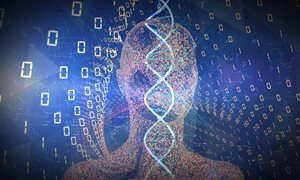
In this blog-interview series, we present the Radboudumc Technology Centers (RTCs) – your gateway to technological expertise, state-of-the-art equipment, and invaluable resources. Each part will spotlight one of the 19 RTCs housed within our campus. Stay tuned for insightful introductions!
Unlike my previous walk, when our campus was covered with a thin blanket of snow, rendering everything uniformly white, today, the rare, but bright presence of the sun against a cloudless blue sky accentuates the green gradient of the grass field in front of me. A fine opportunity to refuel my vitamin D, which is otherwise reaching a critical level. My destination is the Department of Radiology. It should be located somewhere in the cubical building on the left. There, I am meeting Silvan Quax from RTC Deep Learning, though I have to find him first...
Text continues after image
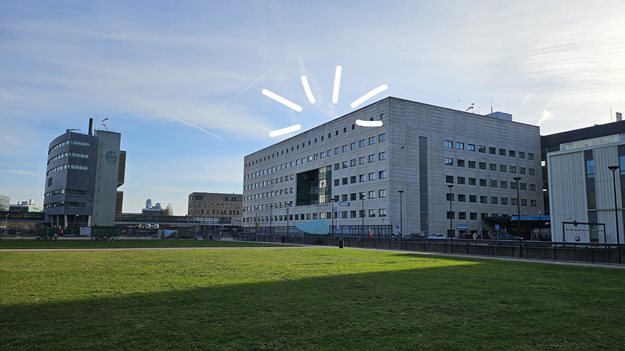
The diagnostics building. Radboudumc's first new building on the south side of Geert Grooteplein, housing the departments of Radiology, Nuclear Medicine, Central Endoscopy, Medical Microbiology, Cardiac Catheterization and Pathology.
“Hi Silvan, I am happy to find you. It’s very much like a maze here with all these small corridors leading in every direction. Somehow, I also missed the RTC sign board I used to see at other RTCs. But I made it to your office anyway.”
“I'm glad you found your way, Hasan. Good point! We don't actually have such a signboard yet, but I'll see if I can arrange one for our RTC. Let's take a seat.”
“Thanks!”
While I get seated, my eyes fall on the computer screens on his desk. One is filled with lines of codes, and on the other I see a colorful round shape and some red wavy lines.
“Before we start with the RTC and the interesting work you were just busy with, let us get to know you better. Who are you, and what led you to take on the role you have now?”
“I am Silvan Quax, coordinator of the RTC Deep Learning. I became fascinated by AI during my studies in Physics when the first neural networks were emerging which led to major scientific breakthroughs. I wanted to understand these new AI systems better and went on to do a PhD on the similarity between AI and how our own brains work. Afterwards, I wanted to contribute to AI systems that can have a positive impact on our society, and I became coordinator of the AI for Health program in the Radboudumc, where we supported many AI projects over the past couple of years. Recently, I have taken over the role of coordinator of the RTC Deep Learning, where we aim to support even more AI initiatives in the coming years.”
“Nice to hear about your story. So, I understand that the RTC Deep Learning was established in 2019, making it the youngest of all the 19 RTCs at Radboudumc. What can you tell us about it?"
“The RTC Deep Learning (RTC DL) consists of a team of Artificial Intelligence (AI) experts, or Deep Learning engineers as you may also call it, that provide expertise on developing, implementing and using AI in healthcare. Our RTC emerged from the Diagnostic Image Analysis Group (DIAG), which is part of the Departments of Imaging, Pathology, Radiation Oncology, Cardiology, and Neurology of Radboudumc. Due to the increasing number of requests for collaboration on AI projects, they decided to start an RTC, so that they would be better equipped to provide the necessary support. The RTC DL is backed by the expertise of a large team of Research Group Leaders and PhD candidates. Now that more and more people learn about AI, the number of AI related questions and support requests we receive is growing rapidly. We try our best to meet all the requests, but unfortunately, we don't have the capacity to support every request.”
“I see. For those who are not very familiar with the term Deep Learning, can you perhaps explain it?”
“Sure. Deep Learning is the AI technique behind many of the big AI advances we have seen in recent years, such as automatic imaging diagnostics and ChatGPT. This AI technique is able to learn complex patterns in large data sets. It uses algorithms that mimic the workings of the human brain, so-called ‘neural networks’. Deep learning is especially suited to recognize patterns in (medical) image data, for example to help in diagnostics. But also in other medical areas where large amounts of data are available, such as genetics, temporal monitoring or large texts (patient records), deep learning can greatly enhance your research or clinical practices.”
“That's a good way to go, I believe, especially given the current and anticipated challenges in the medical field, such as personnel shortages and an aging population. Now, coming to my usual question: what are the specific services you provide?”
“We offer support regarding all aspects of AI in healthcare. From the initial concept of a possible AI algorithm for research or clinical purposes, until the validation and implementation of a working model. Developing an AI algorithm requires many different steps, such as defining a clear purpose of the algorithm, collecting and preparing large amounts of data, training and validating models and eventually implementing and maintaining a successful model. We can provide advice, expertise and appropriate infrastructure during all these steps, whether you would like to develop it yourself or let us develop and implement it for you.”
“I've also heard about an AI platform developed here that's being used globally. Am I right?”
“Yes, that's correct. To facilitate AI development, our team of software engineers indeed have developed the Grand-Challenge platform, currently with over 94,000 users worldwide, and we're aiming to reach 100,000 soon! This platform provides convenient tools for archiving and annotating data, training and deploying AI algorithms and validating them. Currently, our platform contains already more than 100.000+ patients and algorithms for hundreds of diseases. We also have a strong data team that can retrospectively collect and anonymize patient data for research purposes.
For the training of AI models, we also have a specialized computing cluster here in the basement of the Radboudumc. Let’s go there, where we can show you our ‘supercomputers’ who do all the computing necessary for our services.”
As he finishes his sentence, he smiles and glances past me to the silent, yet timely arrival of a colleague who is holding a set of keys in his hand.
“This is Clement Grisi, he is a PhD candidate in the Computational Pathology Group, as part of the DIAG. Together with other PhD candidates from DIAG, he is responsible for the maintenance of the computers he’ll show us in a minute.”
Text continues after image
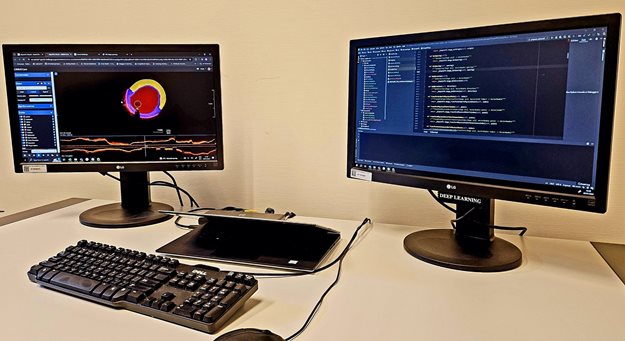
The 'Cardiac Optical Coherence Tomography (OCT) AI' app, developed by Silvan Quax from RTC DL in collaboration with Jos Thannhauser from the Cardiology department, can detect vulnerable plaques in coronary arteries
I am guided down to the basement floor. Once we leave the staircase at -1 and enter the imaging facility, I see a big closet against a wall, stacked with blue suits. We continue our walk through the seemingly quiet hallway with numerous rooms, until we come to a stop in front of a door labeled with ‘Camera-bewaking’ (camera surveillance). As soon as Clement opens the door, the once silent atmosphere is abruptly disrupted by a loud, ventilation-like sound…
“So these are the servers filled with deep learning graphic processing unit (GPU) that make our computer cluster, Sol”, explains Clement, with a raised voice.
Silvan interrupts and adds laughingly that the name refers to the Latin word for ‘sun’, probably because of the massive heat these units are producing, and perhaps because of being the ‘core’ of the facility.
Clement: “And that is exactly the reason why you hear so much noise here. The cooling fans, and those two large hard-working air-conditioning units on the wall ensure the room stays cool to prevent the computer from overheating. Maintaining these computers is one of my responsibilities.”
The room is indeed chilly, and these computer clusters look monstrous.
“Can you elaborate on the computer maintenance you mentioned. What exactly do you do?”
Clement: “Yeah, no problem. As you can see, there are a lot of computers here, running continuously. That means that constant surveillance is needed. Computer components are not immortal: after some time (usually 2-3 years), some are more prone to give errors. It's our job to actively fix these errors, which sometime entails replacing faulty components.”
He points at a box on the ground, filled with ‘old’ backup disks, and continues:
“But performing regular software updates and fixing (software) issues is also part of our maintenance duty. Also, don’t forget the interruptions of the electricity supply, for which we should carefully shut down the whole system in advance and reboot again as soon as the interruption ends. We still need to think about whether we should make use of cloud services or keep it as it is...
In the coming weeks, we will be busy with splitting the big GPU units, into smaller GPU units, to be able to run more tasks in parallel.”
“That sounds very interesting... and challenging, to say the least”
I take a moment to take a nice picture of these ‘big boys’, before we exit the room. As we walk back to the offices, the corridors are filled with the smell of fresh toast. I thank Clement for his insights and wish him good luck surveilling those supercomputers, and his PhD projects. He then leaves us.
“It was a pleasure to tour the facility, Silvan. Thanks a lot! This brings me to my final question: how can we make use of your services?”
“To support your AI projects as good as possible, it is best to involve us as early as possible in a project. At the start of a project, we can help out with defining a clear task that AI is able to solve, and estimating how much data is necessary to develop such an AI. When the AI task is clearly defined and the data is collected, our experts can help with developing the AI model, either by allocating hours in a grant proposal or through a quotation. We can then develop an AI model as a proof of concept to test how well it can perform a task. Such a proof of concept can help greatly with acquiring further funding from grants or from industry partners, so that it can eventually make an impact on actual patient care.
Furthermore, we can help with the validation of external AI products that departments consider implementing. Algorithms can be biased in many ways, and we have seen quite some examples where algorithms perform very different on our local patient population.”
“So, I can just email you?”
“If you are planning a project that involves AI and you would like some expert guidance and support, you can reach out via email. We have a consultation hour every Tuesday between 15-16h, where we can think with you about the possibilities of AI in your work. They take place at our RTC, which is located in the Radiology Department, route 767, room 27. You can also email me if you need more information or visit the RTC DL page on Radboudumc homepage or on the Radboud Imaging website.”
“Great! With that, we've covered all the bases. Nice to meet you, Silvan, and to learn more about your contributions to future-proof medical diagnostics and research. Hope our readers can agree with that. Thanks a lot and best of luck for you and your team!”
Walking back the corridors of Radiology, on a bridge with modern-looking red and purplish chairs, I catch a top-view glimpse of the southern flank of our campus. The Research Tower, the Education Center, the Experience Center... (and the same green grass field where this story started). It makes me reflect on the diverse and impactful work happening under a single umbrella. In every corner of each building, you witness an almost completely different world of expertise. And despite the (often interpersonal) challenges we might experience on a daily basis, some more frustrating than others, it's nonetheless very inspiring to see how our collaborative work can lead to such concrete and beautiful achievements!
Enough said. Till our next blog!
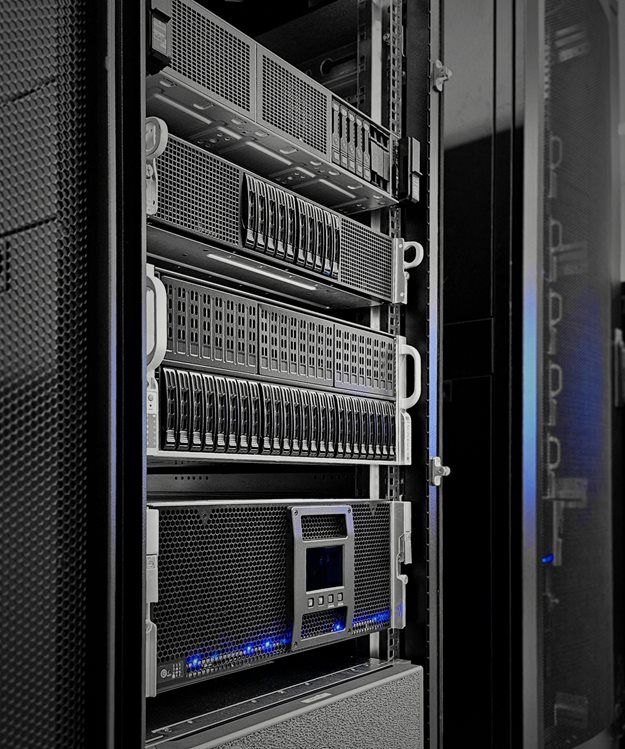
One of the big GPU clusters of Sol
-
Interview by Hasan Erkan (email)
Editor Radboudumc Research Newsletter
You can find all editions of our blog series on this page
Related news items

AI for Health course open for applications
18 October 2022Have you ever thought about exploring and understanding the field of artificial intelligence? Due to the successes in past years, another AI for Health course will be held in 2023. Make sure you secure your spot now!
go to page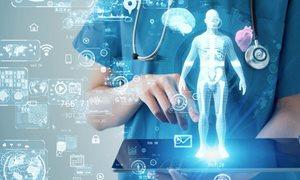
LUMO Labs and Oost NL invest in Aiosyn Investment accelerates development of artificial intelligence platform to improve diagnostics
7 February 2022 Aiosyn, a spin-off from Radboudumc, has received an investment from LUMO Labs. Oost NL is a co-investor. go to page
AI for Health course open for applications
11 November 2021Have you ever thought about exploring and understanding the field of artificial intelligence? Due to the successes in past years, another AI for Health course will be held in 2022. The deadline for application is 17 December 2021, so make sure to reserve a spot!
go to page